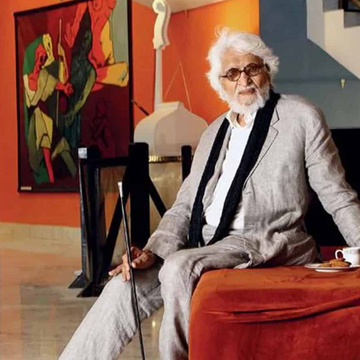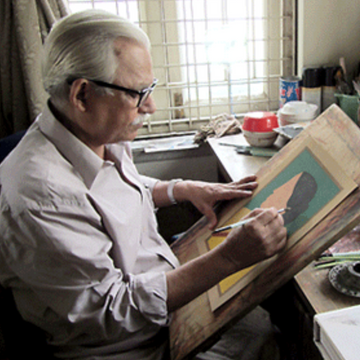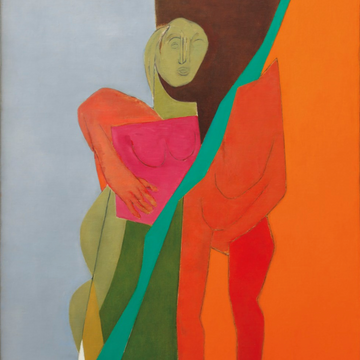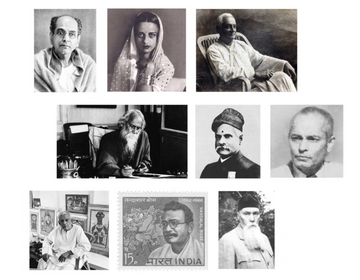Jan 04, 2024 ghate prajwala
Why M.F. Husain is considered the most famous master of Modern Indian Art

The world knows M.F. Husain as one of the greatest and most well-known masters of Modern Indian Art – in 2020, “Voices” (1958) sold at an auction for Rs 18.5 crore – but Husain saw himself first and foremost as the artist of the common man. And that’s because he never lost sight of his humble beginnings. Maqbool Fida Husain was born in a poor family in Pandharpur, Maharashtra in 1911, and lost his mother by the time he was two years old. His mother’s early death was a wound Husain carried through life. According to journalist Tim Adams in The Guardian, Husain believed his painting “was always an attempt to fill that maternal absence.” Husain showed an interest in art from an early age and wanted to study at the J.J. School of Art at Bombay, but his father couldn’t afford the fees. Teaching himself how to draw and paint, in 1935, Husain moved to Bombay to make a living as an artist. The first job he found was to paint cinema hoardings, often gigantic. This early experience influenced his art in different and profound ways. Husain is often painted on the streets, surrounded by poor street vendors, the homeless, and prostitutes. Immersing himself in this world gave him a unique understanding of art that appealed to common people. The billboards he painted on were often gigantic and made Husain evolve a visual vocabulary that was bold, vivid, and larger-than-life. Husain’s work and interest in cinema further shaped an artistic language that was narrative in tone, always keen to tell a story to his audience.
Image courtesy: Christie’s
Though Husain’s journey from penniless billboard painter to an iconic, world-class artist wasn’t easy, he had a knack for turning disadvantages into strengths. Initially, he also made wooden toys in a workshop to support himself; a job he would later say taught him how to use his fingers and hands better. He kept up his independent artistic practice in parallel to his jobs, selling his first painting on the roadside for a mere Rs 10! By the 1940s, the side jobs – including designing furniture – brought him a steady income, giving him the freedom to perfect his signature style. Along with his love for cinema and his years as a painter of hoardings, Husain’s fluid, thick lines and geometrical figures were also influenced by the cubist art tradition of Europe and the Americas. But what set him apart was that he used the cubist tradition to paint distinctly Indian subjects, capturing India in all its multicultural, chaotic glory.
Image courtesy: Google Arts and Culture
As his distinctive-looking paintings – and personality; Husain often went shoeless deliberately – began making a name, in 1947 he co-founded the Progressive Artist’s Group in Bombay. The group included other modern masters like F.N. Souza and challenged the Bengal School and other ideas then dominating Indian painting. While the Bengal School looked at past folk traditions and nationalistic themes for inspiration, the eyes of the Progressive Artist’s Group were trained on the future and a new, young, modern India. Husain’s first exhibition (as part of a group) in 1947 was panned by critics who supported the Bengal school; since his style was deemed too Western. However, after India gained independence and the emphasis grew on creating a national identity that was inspired by both tradition and modernity, Husain’s star began to ascend in earnest. The artist now spent more time in Delhi, where his arresting-looking paintings grew in popularity. In the mid-1950s, Husain was honoured by the Lalit Kala Akademi, and in 1955, he won the prestigious Padma Shree Award. According to Manu S. Pillai in The Mint, “in the 1960s Husain was not only earning several thousand rupees apiece for his work but could also afford a car and other luxuries. The teenager who was thrilled with ₹ 10 once grew into a celebrated painter, one of India’s most prominent faces in the international avant-garde.” His career grew from strength to strength, and in 1991, Husain was awarded the Padma Vibhushan – the country’s second-highest civilian award – by the Government of India for his contributions to Indian art.
Image courtesy: Tallenge Store
But what made Husain- the grandson of a tinsmith from a village in Maharashtra – come such a long way, where his name is now synonymous with Modern Indian art? Why is Husain called the Picasso of India? Two reasons contribute to his undimmed reputation. One is the sheer longevity and diversity of his career. Already a famous painter in the 1960s, Husain continued to evolve as an artist through the 2000s. He also continued his love for cinema, making films with a pathbreaking visual idiom such as Through the Eyes of a Painter, which won the National Film Award for Best Experimental Film in 1967, Gaja Gamini (2000) and Meenaxi: A Tale of Three Cities, (2004), screened in the Marché du film section of the 2004 Cannes Film Festival.
Image courtesy: Art Market Monitor
The other – and biggest – reason for his long-lasting reputation is the iconic style and subject of his painting. Husain painted on a grand scale – his paintings can often be 10-ft tall and in one instance, 60-ft wide – in Technicolor, and his images captured motion and fluidity. Most importantly, his works always told a story: that is why he often painted series, depicting different episodes of a theme, such as his famous Mahabharata collection. His storytelling technique also utilized wide and parallel frames, such as diptychs and triptychs. Despite using artistically advanced methods and complex ideas, his art is always accessible and visually impactful. He deals equally with subjects as diverse as India’s Independence and popular Bollywood celebrity, as exemplified by his paintings inspired by the actor Madhuri Dixit, his muse through the 1990s.
Image courtesy: Christie’s
Often his figures – human and animal – occupy the centre stage of his canvas against ombre-tinged or solid colourful backgrounds. Their faces can be featureless or abstract, but their shapes are drawn with dark, fluid lines. Husain’s famous horses are so animated they seem to jump off the canvas; his women so evocative they capture centuries of Indian tradition and modernity. Though he looked at abstract artists like Paul Klee for inspiration, Husain’s subjects are thoroughly Indian. In fact, over the decades his paintings capture different aspects of Indian culture. From Indian Gods and Goddesses to real-life figures like Mahatma Gandhi, Mother Teresa, and Indira Gandhi; from India’s independence to the controversial period of Emergency in the 1970s and beyond, Husain’s art is a document of modern India.
Image courtesy: Google Arts and Culture
His influences were as diverse as his subjects. As a child, Husain was in love with Ram Lila performances in his village, which ignited a life-long love for multi-faith Indian culture and mythology. The loss of his mother made female energy a perpetual fascination. Husain’s female figures, from Mother Teresa to everyday women, to Indian Goddesses – powerful, and magnetic – show his longing for the maternal life force. As a young painter, He greatly admired the use of colour by European artists such as Klee and Henry Matisse, which is evident in the glowing colours of his canvass. Though his abstract and cubist inspiration is often discussed, the truth is Husain was equally inspired by Indian art traditions like the murals of Ajanta and Ellora, miniature painting, temple sculpture, Buddhist and Jain art, among others. Taken together, these many influences can be seen in his most famous paintings. “Zamin” (Earth) 1955, inspired by legendary film-maker Bimal Roy’s film Do Bigha Zamin is a wide panorama of a rural worker’s relationship with the earth. Reminiscent of cubist stylings, cinematic vision, and the art of the Indus Valley Civilization, this breath-taking work contains Husain’s signature motifs such as the bull, the tree, and the wheel. “Battle of Ganga and Jamuna” (1971), from Husain’s famed Mahabharata series, is a diptych with the two juxtaposed panels in blended and contrasting colours depicting the conflict between right and wrong. Its use of colour and lines is a fascinating mix of Indian sculptural traditions and abstract art. Completed in 1971, the painting fetched a whopping 6.5 crore at Christie’s South Asian Modern and Contemporary Art sale in 2008. “Mother Teresa” (1988-1989) is a large painting that is a landmark in the evolution of Husain’s later-day artistic style. The human figures are even more prominent now, and the backdrop less detailed, as if showing the painter’s growing empathy. A prone man lies across the lap of a faceless, protective maternal saree-clad figure depicting Mother Teresa, reminiscent of Christian images of Mary lamenting the body of Christ in her lap. The mixture of soft emotion and hard lines, as well as the fusion of Christian and Hindu iconography, distinguish this painting. “Horses” (1992) is a celebration of one of his most inspiring muses – the horse, a symbol of “grace and freedom” in Husain’s own words. Three white horses, stark against the sunset colours of the backdrop, are captured in raw motion. The cubist strokes immortalize the muscular power and delicate beauty of the animal.
Image courtesy: The Asian Age
Of course, Husain’s long career was not without its share of controversies. His depiction of nude figures of Indian goddesses raised much controversy, and the painter spent the last year of his life in exile away from India. However, his heart – and art – never stopped beating for his beloved country. As he famously said, “I am an Indian-origin painter. I will remain so to my last breath.” His last paintings – painted through his nineties – make a series called Indian Civilization, and depict various aspects of Indian culture from the Mauryan empire to the contemporary age. Husain passed away in London in 2011. Despite all the controversies that plagued him in the later years of his life, his fame as an artist is undiminished.
Title image courtesy: Art Institvte Chicago



















